1.11.2018
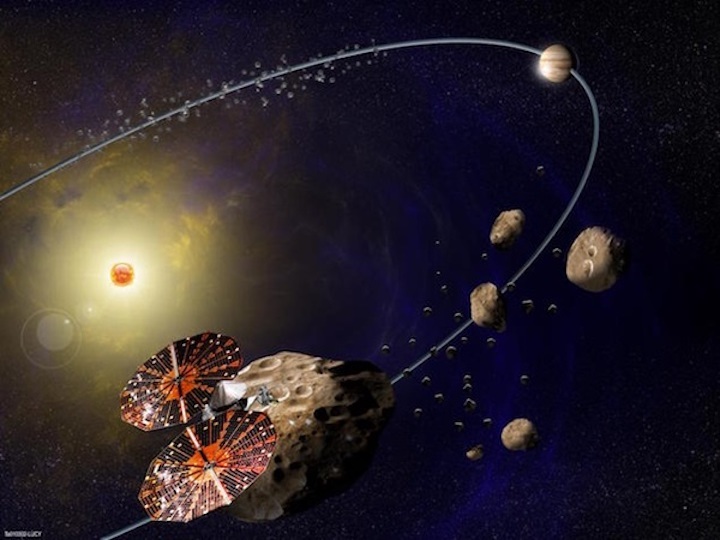
From Ryugu to Bennu, asteroid exploration has been all the rage among astronomers lately. And now, we’re one step closer to exploring some of the most mysterious asteroids in the solar system.
On October 30, NASA announced that they’ve been given the green light to start building Lucy, a spacecraft that will probe Jupiter’s trojan asteroids and is set to launch in October of 2021. On top of giving the go-ahead for construction, NASA has also solidified the mission’s budget, schedule, and its suite of high-powered instruments. The much-anticipated project will study two populations of asteroids caught by Jupiter’s gravity, about which little is known.
A Long Journey
Studying asteroids is a hefty task, and it’s not going to be a quick one, either. The Lucy mission, named after the 3.2 million year-old hominin fossil who helped us understand human evolution, will take almost 12 years to complete. Once it’s finished, though, the craft will have probed seven different asteroids — six trojans and one main-belt asteroid between Mars and Jupiter.
After launching from Cape Canaveral, the craft will orbit twice around Earth before relying on a gravity assist to fling it out into space. In this slingshot-like maneuver, Lucy will approach Earth from behind and dip briefly into its strong gravitational field for a speed boost. This move will help both reduce the mission’s overall travel time and cut down on the amount of heavy fuel it needs to carry.
The first stop on its celestial voyage will be at 52246 Donaldjohanson, a small main-belt asteroid named after the famous paleoanthropologist who discovered Lucy. It will orbit close to the asteroid and use its infrared mapping spectrometer, thermal infrared spectrometer, and high-resolution visible imager to study its surface composition and physical properties.
With one asteroid under its belt, the mission will continue on its journey to the trojans. These famous asteroids circle the Sun in the same orbit as Jupiter, with one massive group flying ahead of the gas giant, and another trailing behind at what’s known as Lagrangian points. Using the same instruments and techniques, Lucy will probe four trojans in the group leading Jupiter and two in its orbital trail.
Uncovering the Past
When it comes to tracking our solar system’s history, Lucy’s data could prove highly valuable. It’s believed that asteroids are ancient fragments leftover from our solar system’s formation, and that they, unlike planets and moons, have roughly the same structure and chemical composition that they did when they first formed. It’s also thought that asteroids could have transported organic molecules, like water, to larger celestial bodies.
By determining the compositions of these relics, Lucy could gain insight into the chemical elements that made up our infant solar system, and help researchers trace its formation and evolution.
Quelle: Astronomy
+++

NASA's mission to perform the first reconnaissance of the Trojans, a population of primitive asteroids orbiting in tandem with Jupiter, passed a critical milestone today. NASA has given approval for the implementation and 2021 launch of the Lucy spacecraft.
The confirmation review, formally known as "Key Decision Point C," authorized continuation of the project into the development phase and set its cost and schedule. The confirmation review panel approved the detailed plans, instrument suite, budget and risk factor analysis for the spacecraft.
The next major mission milestone, the Critical Design Review, will examine the detailed Lucy system design. After a successful critical design review, the project team will assemble the spacecraft and its instruments.
“Up until now this mission has entirely been on paper,” said Lucy Principal Investigator Hal Levison of the Southwest Research Institute at Boulder, Colorado. “Now we have the go ahead to actually cut metal and start putting this spacecraft together.”
Lucy, the first space mission to study the Trojans, takes its name from the fossilized human ancestor called “Lucy” by her discoverers whose skeleton provided unique insight into humanity's evolution. Likewise, the Lucy mission will revolutionize our knowledge of planetary origins and the formation of the solar system.
Lucy is planned for launch October 2021. During its 12-year journey, the spacecraft will visit seven different asteroids - a Main Belt asteroid and six Trojans. The spacecraft and a remote-sensing instrument suite will study the geology, surface composition, and bulk physical properties of these bodies at close range.
“Today’s confirmation of Lucy is a key step towards better understanding the role that small bodies played in the formation of the Solar System and life on Earth,” said Adriana Ocampo, Lucy’s program executive at NASA Headquarters in Washington, DC. “We congratulate the entire team for their hard work.”
Southwest Research Institute (SwRI) in Boulder, Colorado is the principal investigator institution and will lead the science investigation. NASA’s Goddard Space Flight Center in Greenbelt, Maryland, will provide overall mission management, systems engineering and safety and mission assurance. Lockheed Martin Space Systems in Denver, Colorado, will build the spacecraft. Instruments will be built by Goddard, the Johns Hopkins Applied Physics Laboratory in Laurel, Maryland, and Arizona State University in Tempe.
Quelle: NASA
----
Update: 21.12.2018
.
Lucy Finds Its Place in the Solar System: Navigating NASA’s First Mission to the Trojan Asteroids
In science fiction, explorers can hop in futuristic spaceships and traverse half the galaxy in the blink of a plot hole. However, this sidelines the navigational acrobatics required in order to guarantee real-life mission success.
In 2021, the feat of navigation that is the Lucy mission will launch. To steer Lucy towards its targets doesn’t simply involve programming a map into a spacecraft and giving it gas money – it will fly by six asteroid targets, each in different orbits, over the course of 12 years.
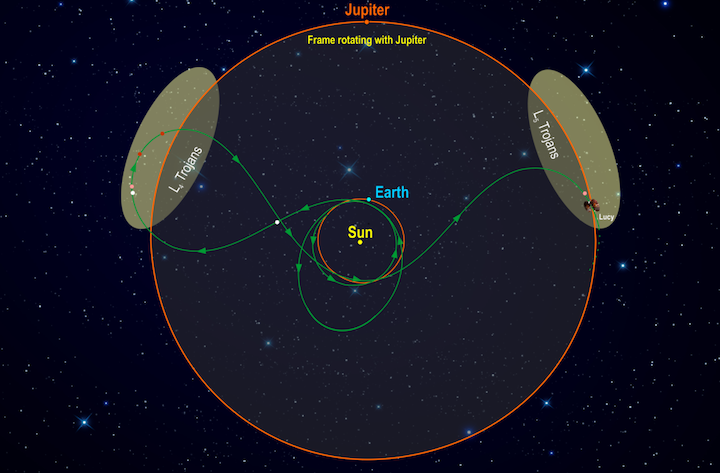
Lucy’s destination is among Jupiter’s Trojan asteroids, clusters of rocky bodies almost as old as the Sun itself, and visiting these asteroids may help unlock the secrets of the early solar system. Lucy will encounter a Main Belt asteroid in 2025, where it will conduct a practice run of its instruments before encountering the first four Trojan targets from 2027-2028. In 2033, Lucy will end its mission with a study of a binary system of two Trojans orbiting each other.
Getting the spacecraft where it needs to go is a massive challenge. The solar system is in constant motion, and gravitational forces will pull on Lucy at all times, especially from the targets it aims to visit. Previous missions have flown by and even orbited multiple targets, but none so many as will Lucy.
Scientists and engineers involved with trajectory design have the responsibility of figuring out that route, under Flight Dynamics Team Leader Kevin Berry of NASA’s Goddard Space Flight Center in Greenbelt, Maryland. One such engineer is Jacob Englander, the optimization technical lead for the Lucy mission. “There are two ways to navigate a mission like Lucy,” he said. “You can either burn an enormous amount of propellant and zig-zag your way around trying to find more targets, or you can look for an opportunity where they just all happen to line up perfectly.” To visit these aligned targets, the majority of Lucy’s high-speed lane changes will come from gravity assists, with minimal use of fueled tweaks.
Though Lucy is programmed to throw itself out into a celestial alignment that will not occur for decades, it cannot be left to its own devices. Once the spacecraft begins to approach its asteroid targets, optical navigation is the next required step.
“OpNav,” as optical navigation technical lead Coralie Adam refers to it, is the usage of imagery from the on-board cameras to determine Lucy’s position relative to the target. This is a useful measurement used by the navigation team to tweak Lucy’s route and ensure it stays on the nominal flyby path. Adam works in Simi Valley, California, with KinetX, the company NASA selected to conduct Lucy’s deep space navigation.
By using the communications link from the spacecraft to Earth, Adam said, the Lucy team gets information about the spacecraft’s location, direction and velocity. The spacecraft takes pictures and sends them down to Earth, where Adam and other optical navigators use software to determine where the picture was taken based on the location of stars and the target. The orbit determination team uses this data along with data from the communications link to solve for where the spacecraft is and where it is expected to be, relative to the Trojans. The team then designs a trajectory correction maneuver to get Lucy on track. “The first maneuver is tiny,” said navigation technical lead Dale Stanbridge, who is also of KinetX. “But the second one is at 898 meters per second. That’s a characteristic of Lucy: very large delta V maneuvers.” Delta V refers to the change in speed during the maneuver.
Communicating all of these navigation commands with Lucy is a process all on its own. “Lockheed Martin sends the commands to the spacecraft via the Deep Space Network,” Adam said. “What we do is we work with Lockheed and the Southwest Research Institute, where teams are sequencing the instruments and designing how the spacecraft is pointed, to make sure Lucy takes the pictures we want when we want them.”
“The maneuvers to correct Lucy’s trajectory are all going to be really critical because the spacecraft must encounter the Trojan at the intersection of the spacecraft and Trojan orbital planes,” Stanbridge said. “Changing the spacecraft orbital plane requires a lot of energy, so the maneuvers need to be executed at the optimal time to reach to next body while minimizing the fuel cost.”
While Lucy is conducting deep space maneuvers to correct its trajectory toward its targets, communications with the spacecraft are sometimes lost for brief periods. “Blackout periods can be up to 30 minutes for some of our bigger maneuvers,” Stanbridge said. “Other times you could lose communications would be when, for example, the Sun, comes between the Earth tracking station and the spacecraft, where the signal would be degraded by passing through the solar plasma.”
Losing contact isn’t disastrous, though. “We have high-fidelity predictions of the spacecraft trajectory which are easily good enough to resume tracking the spacecraft when the event causing a communication loss is over,” Stanbridge said.
What route will Lucy take once its mission is complete, nearly 15 years from now? “We’re just going to leave it out there,” Englander said. “We did an analysis to see if it passively hits anything, and looking far into the future, it doesn’t.” The Lucy team has given the spacecraft a clear path for thousands of years, long after Lucy has rewritten the textbooks on our solar system’s history.
The Lucy mission is led by Principal Investigator Dr. Hal Levison from Southwest Research Institute in Boulder, Colorado. NASA Goddard in Greenbelt, Maryland, manages the mission. Lockheed Martin Space in Denver will build the spacecraft and conduct mission operations.
Quelle: NASA
----
Update: 2.02.2019
.
ULA to launch NASA's Lucy mission, named after the Beatles, to Jupiter's asteroids
The Space Coast can expect to see yet another deep-space NASA science mission blast off on an Atlas V rocket from Cape Canaveral Air Force Station.
NASA on Thursday announced the selection of United Launch Alliance's rocket to launch the upcoming "Lucy" mission from Launch Complex 41 no earlier than October 2021.
“We could not be more pleased that NASA has selected ULA to launch this amazing planetary science mission,” ULA CEO Tory Bruno said in a release.
The program, which plans to send a spacecraft to Jupiter's Trojan asteroids, would be the first time a mission would fly to several different destinations in independent orbits around the sun, according to NASA.

Named after a fossilized human ancestor discovered in 1974 and the Beatles song "Lucy In The Sky With Diamonds," NASA's mission aims to uncover the secrets of how the solar system first formed more than four billion years ago.
The Atlas V family of rockets previously launched other NASA science missions aimed at learning more about solar system formation. Those include NASA's InSight, New Horizons and OSIRIS-REx.
Lucy, however, will be the first mission to Jupiter's asteroids.
Two groups of asteroids, known as Jupiter's Trojans, swarm along the planet's path around the sun: One travels ahead of Jupiter's orbit and the other always lags behind.
Scientists believe these asteroids may be remnants from the primitive materials that formed the outer planets. By sending spacecraft to gather information, researchers hope to understand more about the origins of planets.
"Lucy, will show us, for the first time, the diversity of the primordial bodies that built the planets," according to NASA. "Lucy's discoveries will open new insights into the origins of our Earth and ourselves."
Lucy will complete a 12-year journey to seven different asteroids.
ULA has successfully launched 132 missions to orbit. The company is scheduled to launch the Air Force's 10th Wideband Global SATCOM communications satellite aboard a Delta IV rocket no earlier than March 13 from Launch Complex 37.
Quelle: Florida Today
----
Update: 22.10.2019
.
NASA’s Lucy Mission Clears Critical Milestone
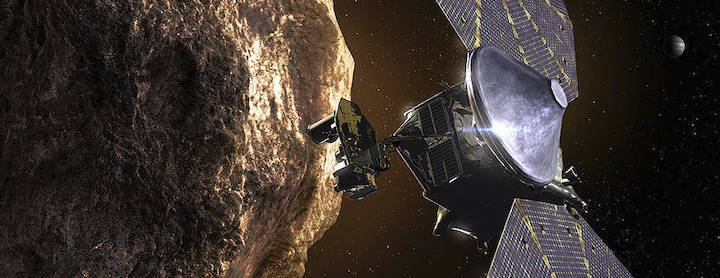
NASA’s Lucy mission successfully completed its Critical Design Review on Oct. 18.
During this review, Lucy team members presented the completed mission design, demonstrating that the team has met all the technical challenges of the mission and is ready to begin building hardware. After the review completion, NASA's independent review board provided a green light for proceeding into the fabrication/manufacturing stage of the mission.
The Lucy Critical Design Review began on Oct. 15 at Lockheed Martin in Littleton, Colorado. This major mission milestone marks the culmination of months of reviews of all of the mission systems and subsystems. Over four days, the independent review board, comprised of reviewers from NASA and several external organizations, heard presentations on all aspects of the mission design. All aspects of the mission were addressed, including the Lucy spacecraft and its instrument payload, system-level test plans for flight hardware and software, systems engineering, mission assurance, the ground system, and science.
"This is a very exciting time for us because we are moving beyond the design phase and a really starting to build the spacecraft, said Hal Levison, Lucy principal investigator from Southwest Research Institute in Boulder, Colorado. “It is finally becoming real!"
Critical Design Reviews are one-time programmatic events that bridge the design and manufacturing stages of a project. A successful review means that the design is validated and will meet its requirements, is backed up with solid analysis and documentation, and has been demonstrated to be safe.
Lucy will be the first space mission to study the Trojan asteroids, which orbit the Sun at a distance of Jupiter. The mission will launch in October 2021. With boosts from Earth's gravity, the spacecraft will complete a 12-year journey to seven different asteroids — a Main Belt asteroid and six Trojan asteroids.
“I am constantly amazed at the dedication and diversity of skills that our team brings to this project," said Keith Noll, Lucy project scientist from NASA’s Goddard Space Flight Center in Greenbelt, Maryland. ”Day by day the mission comes into clearer focus and the mission critical design review is the latest milestone in our journey to launch just two years from now.”
Southwest Research Institute (SwRI) in Boulder, Colorado is the principal investigator institution and will lead the science investigation. NASA’s Goddard Space Flight Center, Greenbelt, Maryland will provide overall mission management, systems engineering, and safety and mission assurance. Lockheed Martin Space Systems in Denver, Colorado will build the spacecraft.
Discovery Program class missions like Lucy are relatively low-cost; their development is capped at about $450 million. They are managed for NASA’s Planetary Science Division by the Planetary Missions Program Office at Marshall Space Flight Center in Huntsville, Alabama. The missions are led by a principal investigator, who assembles a team of scientists and engineers to design and conduct the mission to address key science questions about the Solar System.
Quelle: NASA
----
Update: 13.01.2020
.
SwRI-LED LUCY MISSION NOW HAS A NEW DESTINATION
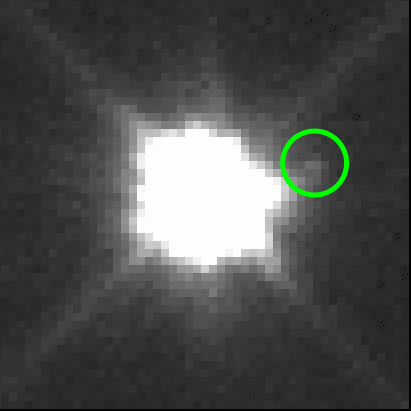
Courtesy of NASA, HST, and Noll Hubble images of Eurybates and its newly discovered satellite shown in this animated gif alternate between the Jan. 3, 2020, detection of the satellite (circled in green) and the Dec. 11, 2019, data when the satellite was too close to the primary to be observed.
January 9, 2020 — Less than two years before launch, scientists associated with NASA’s Lucy mission, led by Southwest Research Institute, have discovered an additional small asteroid that will be visited by the Lucy spacecraft. Set to launch in 2021, its 12-year journey of almost 4 billion miles will explore the Trojan asteroids, a population of ancient small bodies that share an orbit with Jupiter.
This first-ever mission to the Trojans was already going to break records by visiting seven asteroids during a single mission. Now, using data from the Hubble Space Telescope (HST), the Lucy team discovered that the first Trojan target, Eurybates, has a satellite. This discovery provides an additional object for Lucy to study.
“If I had to bet that one of our destinations had a satellite, it would have been this one,” said SwRI’s Hal Levison, principal investigator of the mission. “Eurybates is considered the largest remnant of a giant collision that occurred billions of years ago. Simulations show that asteroid collisions like the one that made Eurybates and its family often produce small satellites.”
This correlates with big Kuiper Belt objects thought to be cousins to the Trojans, which show evidence of both massive collisions and small satellites.
“At the Lucy science team meeting last November, my colleague Keith Noll pointed out a suspicious-looking spot next to an image of Eurybates. I quickly downloaded the next set of data and realized that the spot was still there, but it had moved, just like a satellite would,” said Caltech’s Mike Brown, a Lucy science team member.
“We asked for more HST time to confirm the existence of the satellite, and we were given three tries,” said Noll, Goddard Spaceflight Center’s project scientist for the mission. “In the first two observations, we didn’t see anything, so we began to think we might be unlucky. But on the third orbit, there it was!”
The small object was difficult to spot, in part, because Eurybates is 6,000 times brighter than its satellite. This implies that it’s less than 1 km (0.5 miles) across, which, if correct, would make it among the smallest objects ever visited by a spacecraft.
“Before we believed that it was actually real, we had to make sure that a single satellite could actually fit all of the data,” said SwRI’s Cathy Olkin, deputy principal investigator of the Lucy mission. “Using computer simulations, we demonstrated many possible satellite orbits that match both the observations where we can see the satellite, as well as the times when we don’t.”
While the current data are enough to confirm the existence of the satellite, the Lucy team will collect more HST data later this year to better understand the object’s orbit.
SwRI is the Lucy mission principal investigator institution and leads the science investigation. Goddard Spaceflight Center provides overall mission management, systems engineering, and safety and mission assurance.
Quelle: Southwest Research Institute
----
Update: 7.01.2021
.
NASA’s First Mission to the Trojan Asteroids Integrates its Second Scientific Instrument
NASA’s Lucy mission is one step closer to launch as L’TES, the Lucy Thermal Emission Spectrometer, has been successfully integrated on to the spacecraft.
“Having two of the three instruments integrated onto the spacecraft is an exciting milestone,” said Donya Douglas-Bradshaw, Lucy project manager from NASA’s Goddard Space Flight Center in Greenbelt, Maryland. “The L’TES team is to be commended for their true dedication and determination.”
Lucy will be the first space mission to study the Trojan asteroids, leftover building blocks of the Solar System’s outer planets orbiting the Sun at the distance of Jupiter. The mission takes its name from the fossilized human ancestor (called “Lucy” by her discoverers) whose skeleton provided unique insight into humanity’s evolution. Likewise, the Lucy mission will revolutionize our knowledge of planetary origins and the birth of our solar system more than 4 billion years ago.
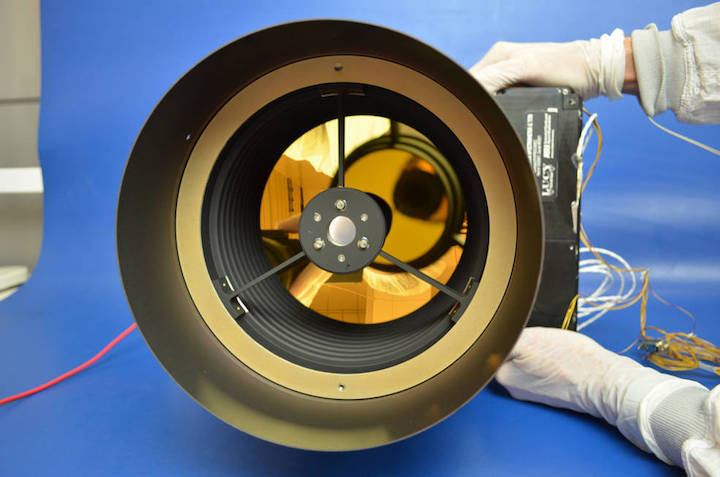
L’TES, developed by a team at Arizona State University (ASU), is effectively a remote thermometer. It will measure the far infrared energy emitted by the Trojan asteroids as the Lucy spacecraft flies by an unprecedented seven of these objects during this first ever mission to this population.
The instrument arrived at Lockheed Martin Space on December 13 and was successfully integrated on to the spacecraft on December 16. By measuring the Trojan asteroids’ temperatures, L’TES will provide the team with important information on the material properties of the surfaces. As the spacecraft will not be able to touch down on the asteroids during these high speed encounters, this instrument will allow the team to infer whether the surface material is loose, like sand, or consolidated, like rocks. In addition, L’TES will collect spectral information using thermal infrared observations in the wavelength range from 4 to 50 micrometers.
“The L’TES team has used our experienced designing, manufacturing, and operating similar thermal emission spectrometers on other missions such as OSIRIS-REx and the Mars Global Surveyor as we built this instrument,” said Instrument Principal Investigator, Phil Christensen. “Each instrument has its own challenges, but based on our experience we expect L’TES to give us excellent data, as well as likely some surprises, about these enigmatic objects.”
Despite the challenges surrounding the COVID-19 pandemics, Lucy is on schedule to launch in October 2021 as originally planned.
“I am constantly impressed by the agility and flexibility of this team to handle any challenges set before them,” said mission Principal Investigator, Hal Levison of Southwest Research Institute. “Just five years ago this mission was an idea on paper, and now we have many major components of the spacecraft and payload assembled, tested, and ready to go.”
In addition to L’TES, Lucy’s High Gain Antenna, which will enable spacecraft communication with the Earth for navigation and data collection, as well as precise measurement of the masses of the Trojan asteroids, was recently installed. It joined L’LORRI, Lucy’s highest resolution camera, built by the Johns Hopkins Applied Physics Laboratory, which was installed in early November. Lucy’s remaining scientific instrument, L’Ralph, the mission’s color imaging camera and infrared spectrometer, is scheduled to be delivered in early 2021.
Southwest Research Institute’s Hal Levison and Cathy Olkin are the principal investigator and deputy principal investigator of the Lucy Mission. NASA’s Goddard Space Flight Center provides overall mission management, systems engineering and safety and mission assurance. Lockheed Martin Space is building the spacecraft. Lucy is the 13th mission in NASA’s Discovery Program. NASA’s Marshall Space Flight Center in Huntsville, Alabama, manages the Discovery Program for the agency’s Science Mission Directorate in Washington, D.C.
Quelle: NASA
----
Update: 24.02.2021
.
How Were the Trojan Asteroids Discovered and Named?
On Feb. 22, 1906, German astrophotographer Max Wolf helped reshape our understanding of the solar system. Again.
Born in 1863, Wolf had a habit of dramatically altering the astronomy landscape. Something of a prodigy, he discovered his first comet at only 21 years old. Then in 1890, he boldly declared that he planned to use wide-field photography in his quest to discover new asteroids, which would make him the first to do so. Two years later, Wolf had found 18 new asteroids. He later became the first person to use the “stereo comparator,” a View-Master-like device that showed two photographs of the sky at once so that moving asteroids appeared to pop out from the starry background.
It is perhaps unsurprising, then, that on Feb. 22, 1906, Wolf made another important discovery: an asteroid with a particularly unusual orbit. As Jupiter moved, this asteroid remained ahead of Jupiter, as though it was somehow trapped in Jupiter’s orbit around the Sun. German astronomer Adolf Berberich observed that the asteroid was nearly 60 degrees in front of Jupiter. This specific position reminded Swedish astronomer Carl Charlier of a peculiar behavior predicted by the Italian-French mathematician Joseph-Louis Lagrange over 100 years earlier. Lagrange argued that if a small body (such as an asteroid) is placed at one of two stable points in a planet’s orbit around the Sun (called the L4 and L5 Lagrange Points), the asteroid would remain stationary from the planet’s perspective due to the combined gravitational forces of the planet and the Sun. Charlier realized that Wolf’s asteroid was actually caught in Jupiter’s L4 Lagrange point. Until Wolf’s discovery, Lagrange’s prediction had only been a mathematical exercise. Now, these astronomers had photographic proof that Lagrange was right.
Eight months later, one of Wolf’s graduate students August Kopff discovered an asteroid in Jupiter’s other stable Lagrange point L5, as well as another asteroid caught in L4 a few months afterward.
Once three of these Lagrange point-inhabiting asteroids had been discovered, astronomers began wondering what to call them. At this point, most asteroids were given the names of women from Roman or Greek mythology, unless their orbits were particularly strange. The asteroids in question certainly had bizarre orbits, so Austrian astronomer Johann Palisa suggested the names Achilles, Patroclus, and Hektor after characters from The Iliad. Achilles was a nigh-invulnerable Greek hero (except for his heel), and Patroclus was a friend of his. Hektor, prince of the Trojans, eventually killed Patroclus, and Achilles exacted revenge by killing Hektor. The recently discovered asteroids were then given Iliad-inspired names.
As astronomers continued discovering asteroids hiding in Jupiter’s Lagrange points, they continued naming them after heroes of the Trojan War and began referring to them as “Trojan asteroids.” (“Trojan asteroids” would eventually refer to asteroids inhabiting any planet’s stable Lagrange points, though names from The Iliad are reserved for Jupiter’s Trojans.) It later became convention to name Jupiter’s L4 asteroids after Greek characters and Jupiter’s L5 asteroids after Trojan characters, so L4 and L5 became the “Greek camp” and the “Trojan camp” respectively. Palisa apparently did not foresee this tradition, for his naming of first three asteroids led to a Greek “spy” residing in the Trojan camp (Patroclus) and a confused Trojan (Hektor) who probably wandered into the Greek camp hoping to order some of their famous custom-built wooden horses.
No spacecraft has ever been to this population of small bodies, called the Trojan asteroids. Now, a new NASA Discovery Program mission called Lucy will fly by seven Trojan asteroids, plus a main belt asteroid, to survey the diversity of this population in a single 12-year record-breaking mission. The Lucy spacecraft launch window opens Oct. 16, 2021.
Southwest Research Institute in Boulder, Colorado, is the principal investigator institution and leads the science investigation. NASA’s Goddard Space Flight Center in Greenbelt, Maryland, provides overall mission management, systems engineering, and safety and mission assurance. Lockheed Martin Space Systems in Denver is building the spacecraft. Spacecraft payload is being provided by Goddard, the Johns Hopkins University Applied Physics Lab, and Arizona State University. The Discovery Program management is executed by NASA’s Marshall Space Flight Center in Huntsville, Alabama.
Quelle: NASA
